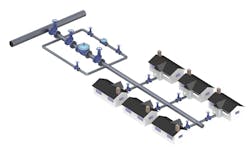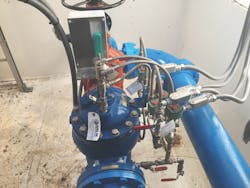Best Practice Pressure Management Systems
Ryan Spooner is engineering manager & control business development for Mueller Water Products. Spooner can be reached at [email protected]. Amit Patel is product marketing manager of food & beverage, water quality for fluid control and pneumatics for Emerson. Patel can be reached at [email protected].
undefinedNon-revenue water (NRW) represents a serious problem for the global water industry. In some municipal, governmental or private water systems, up to 40% of potable water produced can be lost before reaching the consumer.
Recent estimates place global annual NRW—water produced but not billed because of commercial or physical losses—at 126 billion cu meters. This translates to nearly $40 billion in annual losses on waste and foregone revenues—a sum, that even if a fraction could be recovered would underpin a compelling market opportunity for private service companies and a boost to public water utility sustainability.
Reducing NRW is one of the easiest ways to improve the efficiency of water utilities. The water losses in the distribution systems are obvious when analyzing data from them.
“It is more than a decade since the International Water Assn. (IWA) presented the ‘best practice’ standard water balance, but many water utilities have still no overview of the situation,” stated a recent IWA report. “Around the world, NRW accounts for 25% to 50% of the total water supply, and in emerging markets, we have experienced even up to 75% levels.”
Lost Water: Relieving the Pressure
Most water utility directors and superintendents know their systems are experiencing NRW at some level. The questions are how much and why? The NRW problem primarily relates to aging water system infrastructures. The causes usually are found in three areas:
1. Pipe breaks that are caused by line over-pressurization;
2. Leaking pipes that result from stress and deterioration (some large U.S. cities still have some wooden pipes); and
3. Metering inaccuracies that mask problems and deter measurement.
For example, during the day, an industrial zone has 10 companies using large volumes of water. The pressure in the incoming line is 50 psi. However, at night, the flow shuts down when the companies stop working. Pressure builds up in the line, and if the pipes are old, leaks creep in, or worse, the line breaks. The zone now experiences significant NRW loss over time.
Replacing all of a system’s old water lines and control systems would be unthinkable. However, there are cost-effective measures that can efficiently reduce and control water line pressure—the primary cause of stress, leaks and breaks in the system.
Water Pressure Management: The Key to Reducing NRW
Solutions in pressure management are the best ways to solve the NRW problem. By lowering the water system’s pressure, stress levels that cause leaks and breaks are dramatically reduced.
Best practice pressure management programs can range from installing solenoid-equipped hydraulic pressure control valves at key locations to more elaborate systems across the entire water network. These systems permit efficient management of water flows and pressures from a remotely located control panel. They also can be integrated with the utilities supervisory control and data acquisition (SCADA) network.
In a typical pressure management application, a residential zone is fed from a main line at a point that is close to a pump station (see Figure 1 and Figure 2). As a result, the distribution network in the residential zone faces high-water pressure around the clock. Since the pipes to the homes are old and under stress from overpressure, the area has experienced some leakage. The utility may decide to install a pressure-management system to reduce the lost water and improve customer service.
In the main distribution line that feeds the residential area, a pressure-reducing valve (pressure regulator) is installed and controlled by an electronically operated solenoid pilot valve. This combination will limit the outlet pressure of the control valve to a preset pressure, regardless of the flow rate and the inlet pressure.
An additional parallel line typically is installed that bypasses the pressure-reducing valve in the main distribution line. It has a smaller pressure-reducing valve that is used to correct low flows that the larger valve cannot handle. This enables the pressure management system to handle the entire flow range. However, if the main control valve has rolling-diaphragm technology, a low flow rate will not be an issue as this type of valve can regulate down to extremely low flows. As a result, the bypass circuit is not required.
The number of pressure-reducing valves required will depend on the size of the system, how it is plumbed from the pump stations to the end points of the distribution lines, and the elevation it covers. However, all the manual valves will not require replacement. Only key pumping stations and valves must be fully automated to control most of the water flowing through the system.
A well-executed pressure management system will enable the utility to easily regulate the residential zone’s water pressure in real-time throughout the day.
Solenoid Valves Are Critical
A key component in a best practice pressure management system is the solenoid pilot valve, which can be configured to be discrete or in a manifold system. This valve electrically opens and closes the control valve (pressure regulator) that is installed in the waterline. A manual control valve has a single set point. If it needs to be changed, a technician must go to the valve to do it. Converting these valves to electronically controlled operation with a solenoid valve allows the operator to set the change points dynamically. That means set points can be programmed for the time of day, system demand or pressure demand by an operator in a control room. This capability creates the opportunity to adjust and optimize the entire water network for the best possible process control.
Typically, a pressure management system uses two solenoid pilot valves to perform two key functions (see Figure 3):
1. Remote on-off shutoff: This solenoid valve permits the operator to access the control valve remotely. Now, the operator can turn the control valve on or off for safety reasons, line shutdown or time-based control.
2. Remote electronic valve modulation: This solenoid valve enables the modulation of the control valve electronically. With the capability to modulate a control valve from 0% to 100%, pressure-sensor feedback can be used to manipulate the valve through a PID controller to remotely manage the valve to specific set points.
These capabilities allow operators to dump water on or off the valve bonnet cover to allow it to open and close.
Selecting the appropriate solenoid valves for a pressure management system depends on several criteria:
Application: What type of valve configuration is required? Two-way, three-way or four-way solenoid valves may be needed in normally open or normally closed positions. Operators also must decide if the valves will be configured in a manifold or discretely.
Flow capacity: The valve must have enough valve flow coefficent or Cv for correct operation. The proper pressure rating also must be identified. 250 psi may be needed in one application, while 100 psi is appropriate for another. Generally, high-pressure lines require responsive valves with high flow rates.
Reliability: Solenoid pilot valves, such as the ASCO three-way valves, may cycle many times per day depending upon the downstream requirements. The valves must be highly reliable and offer extended service lives.
Material: If the installation environment is corrosive, a stainless-steel construction will be required. Explosion-proof or submersion-proof certification also may be necessary.
Voltage: Depending on the location, 120 VAC or 240 VAC valves will be needed. If the site is running on solar power, 12 VDC should be specified. If the site is remote or has a limited energy supply, solenoid valves are available with extremely low power consumption.
Watertight enclosure: In wet environments, the solenoid coil and leads must be protected against moisture ingress.
Explosion-proof coil ratings: The valves will require Class 1 Division 1 ratings if they are located in a hazardous environment.
Low-power operation: Water systems in remote locations may require low-power solenoid pilot valves, such as the ASCO Next Generation Series. These products have lower energy consumption, ranging from 1.0W DC and 1.5W AC/DC compared to traditional 15W solenoid valves. They are ideal for remote applications with limited electrical availability or for those desiring to lower their cost of ownership.
It is critical that the correct solenoid valves are specified for the application. Working with a technically competent solenoid valve supplier should make this process easier and less expensive.
The Benefits
With the costs of instrumentation and automation declining, installing a best practice pressure management system has become more cost-effective. These systems can generate reductions in NRW loss from pipe leakage and breaks.
One example of those reductions is that water pressure can be dropped or increased in zones, as needed. That provides the ability to run a zone at 30 psi at night and then increase it to 80 psi or more during peak periods; adjusting the pressure to zero for an industrial building that shuts down at night and does not use any water; and redistributing water flow across both the mains and distribution lines, so pressure can be maintained or lowered while back up pressure
is eliminated.
In addition, a modern pressure management system will require less operating and maintenance cost, provide greater system uptime and enable real-time system optimization.
Overall, these benefits mean considerably less wear and tear on piping and components, as well as the prevention of significant NRW losses. Sound pressure management practices are the key to reducing NRW and achieving sizable cost savings and revenue enhancement.



